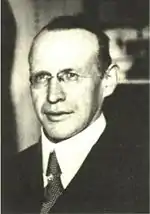Bernhard Stempfle
Bernhard Stempfle (1882 in Munich – 1 July 1934) was a Jesuit priest and journalist. He helped Adolf Hitler in the writing of Mein Kampf.[1] He was murdered in the Night of the Long Knives.

Biography
Stempfle entered the priesthood in 1904. He joined the Hieronymite order (the Poor Hermits of Saint Jerome) in Italy. In the years leading up to the First World War, he wrote for the Corriere della Sera and various other German and Italian papers. Following the outbreak of war, he returned to Munich, performed pastoral work at the university, and established close contacts with Reform Catholic elements (i.e., elements that opposed political Catholicism, and politicians they regarded as too willing to make compromises with the Jews and "atheistic" socialists) in the city, especially the nationalistic Hofklerus at St. Kajetan. In 1919, he first began publishing in the Munchener Beobachter, where he wrote relentlessly on the destructive influence of Jewish atheism and on the moral acceptability and necessity of ruthless persecution of Jews, even as far as pogroms, pursued in defense of the faith and institutions of the Catholic Church, and the example provided throughout the years by anti-Semitic leaders within the hierarchy. By 1920, he was a leader of the secretive anti-republican Organisation Kanzler (Orka) and by 1923 he was the chief editor of the anti-Semitic daily Miesbacher Anzeiger and a leading journalistic figure within the broader volkish-anti-Semitic movement in Catholic Bavaria. He was also a regular confidant of Hitler.[2]
As an increasingly prominent Nazi figure, he was the target of Social Democratic satire and portrayed as the anti-Semitic bishop of Miesbach. He idealized Hitler and attacked the BVP, Center party, and their alleged Jewish backers. According to Hitler's personal photographer Heinrich Hoffmann, Stempfle frequently visited Munich and was a member of Hitler's inner circle, joining Hitler "at his corner table at the Café Heck", and advising him on religious issues.[3]
Multiple authors and eyewitnesses, such as Konrad Heiden[4] and Nazi "apostate" Otto Strasser, report that not only did Stempfle correct the galley proofs of Mein Kampf, but that he indeed copy-edited certain passages. Historian and Hitler biographer Alan Bullock likewise discusses this.[5] (See the German version of this Wikipedia entry for more details.)
In June 1934, having been deported to the Dachau concentration camp, his body was found in the woods near Harlaching. His death is attributed by some accounts to a broken neck and by others to shots in the heart "while trying to escape". There is disagreement also over the reasons for his murder. In some accounts, it is considered possible that he was regarded as having too much information about Hitler's past and personal life, and especially about the death of Hitler's niece, Geli Raubal. Other accounts hold that it was perhaps his attacks on Christian Weber, for immorality and running a brothel, that determined his fate.
References
- Karl Dietrich Bracher, The German Dictatorship, p.111
- Derek Hastings, Catholicism and the Roots of Nazism pp67-68
- Hastings, p.119
- Konrad Heiden: Der Fuehrer. Hitler's Rise to Power, 1944, p. 305; translation of Konrad Heiden: Adolf Hitler. Das Zeitalter der Verantwortungslosigkeit. Eine Biographie, 1936, p. 455.
- Alan Bullock: Hitler. A Study in Tyranny, 1960, p. 120.